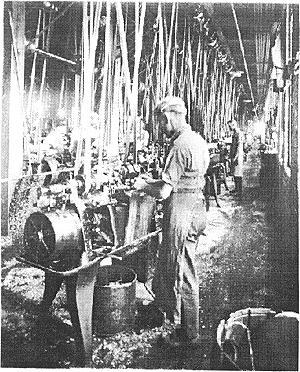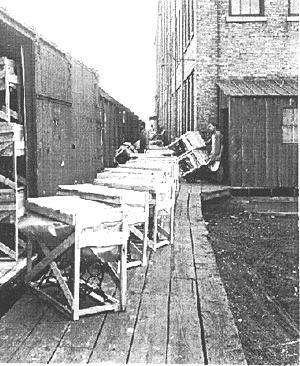The Sewing Machine Factory

Although sewing machines from the earliest makers have survived, I have come across little pictorial evidence of the factories in which they were made. This is a pity as some important manufacturing techniques were pioneered by the sewing machine industry.
The problems of mass production were initially solved by the small arms industry in the USA at the time of the civil war.

From the Colt armoury in Hartford Connecticut came Charles E. Billings and Christopher M. Spencer. Billings had founded the Weed Sewing Machine Co. with George A. Fairfield in Hartford. While with Billings, Spencer devised his automatic turret lathe with "brain wheels" (Fig. 1) which revolutionised the series production of small precision parts. The first parts which Spencer produced were small bobbins for Billings' sewing machines.

Singer, though one of the major early manufacturers, was not in the forefront of using the new automatic machine tools. Much work was hand fitted and major items were contracted out. The James' St. factory in Glasgow, for instance, bought in castings from George Ure's foundry in Bonnybridge and cabinets were imported in pieces from Southbend, Indiana.
Only when the company moved to Kilbowie in 1884 was every part of the machine, including tooling, made on the one site. Sewing machine factories were major employers of labour with Kilbowie employing over 14,000 workers in its heyday around 1906 when it manufactured over a million machines each year.

Photographs and engravings of the exteriors of factory buildings are much more common than pictures of the people at work in the interior. When engravers depicted interiors they usually cleaned them up to show specific trades at work. Figure 2 is an engravings of the Singer Elizabethport NJ forge in the 1880's.
The forge could be any large engineering works with its steam hammer and forest of belting driving machines. Ornamenting the machines required much hand labour . The needle department often had women working in an engineering environment, not so common in the nineteenth century.

For some photographs I have taken examples from a set of 40 stereo pairs of pictures of the National Sewing Machine Co.'s factory at Belvidere Ill. USA about 1920.
They show scenes which were probably unchanged from about 1890 to almost 1950 in some plants. (When Singer ceased production at Kilbowie (Clydebank) in the 1970's there were still machines in use that had been installed for the opening in 1884!) A general history of the National S. M. Co. is given in Graham Forsdyke's article in ISMACS News 55 . The factory was driven from a steam powered central engine house by a forest of shafting and leather belts.

The only automatic machine tools seen are for making small screws. There is little evidence for health and safety measures and only two photographs show inspection or quality control. At the end machines are shown in crates being loaded onto railroad freight cars. I was surprised to see the treadles assembled and not as "flatpacks".






